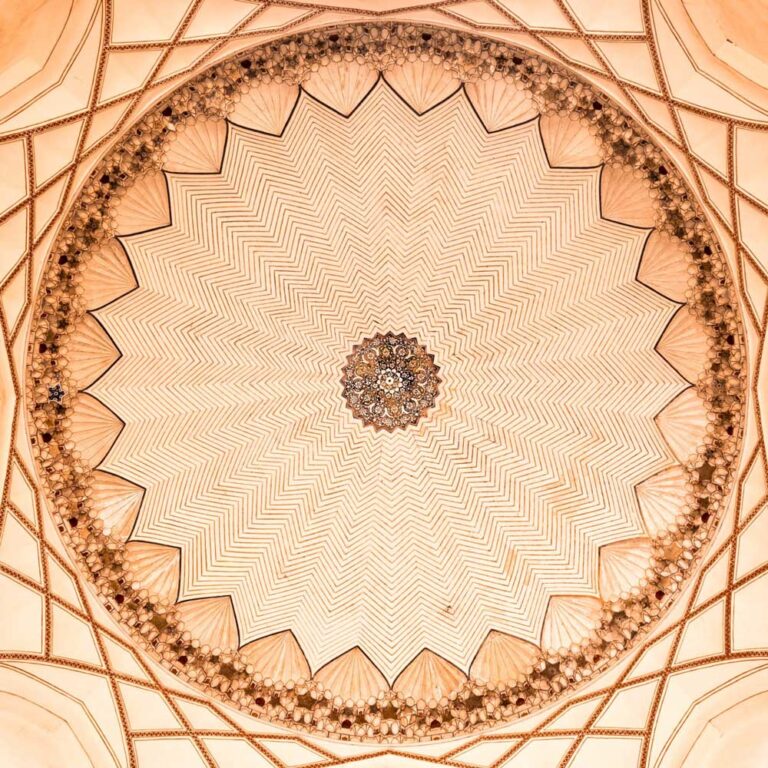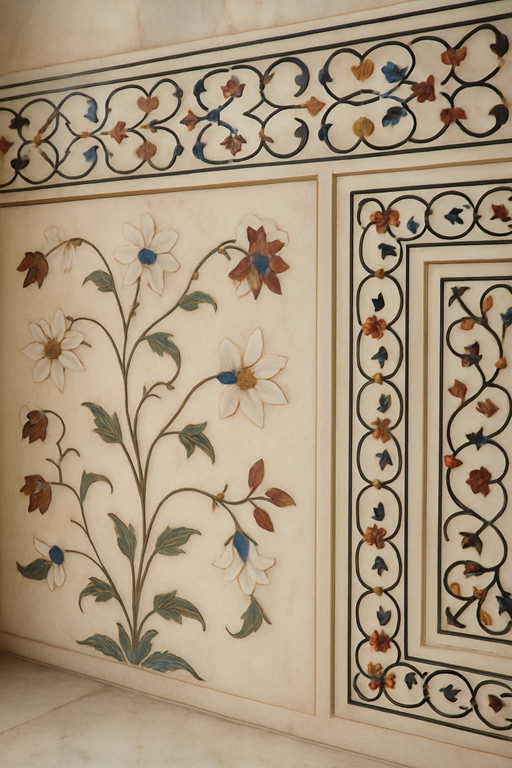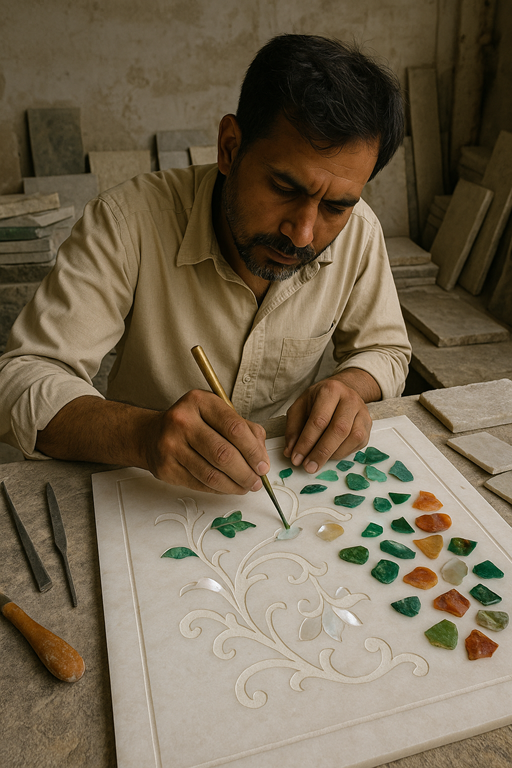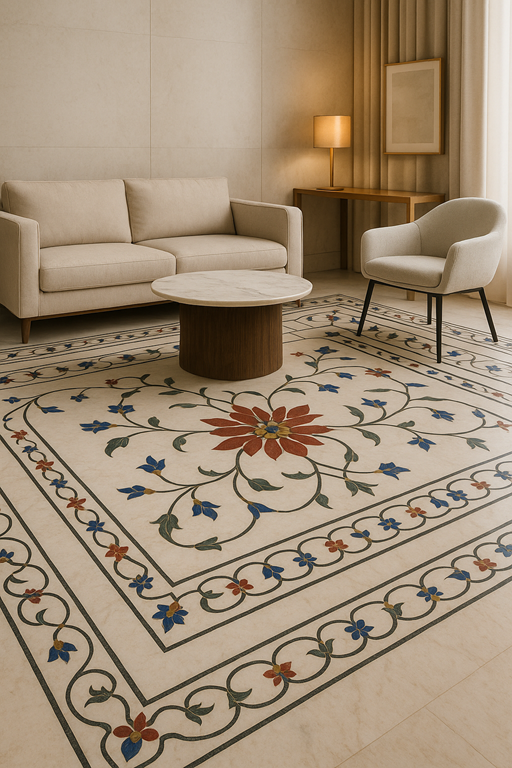Marble inlay flooring is an ancient craft, born in the opulent courts of empires, continues to captivate homeowners and designers today. From the intricate Mughal marble inlays of the Taj Mahal to the bespoke creations of Attari Marble Art in modern homes, this art form is a testament to luxury, precision, and enduring beauty. Let’s journey through the royal history of marble inlay and explore how its legacy thrives in contemporary design.

The Origins of Marble Inlay: A Craft of Emperors
Marble inlay, or pietra dura as it’s known in Italian, traces its roots to ancient civilizations, but it reached its zenith during the Mughal Empire (16th–19th centuries). Mughal emperors, renowned for their love of art and architecture, elevated marble inlay to a symbol of royal grandeur. The technique involves embedding precisely cut semi-precious stones—such as lapis lazuli, agate, and mother of pearl—into marble to create intricate patterns, often floral or geometric.
The Taj Mahal, commissioned by Emperor Shah Jahan in 1632, is perhaps the most iconic example of Mughal marble inlay. Its walls shimmer with delicate floral motifs and arabesques, crafted by artisans who spent years perfecting each design. These historical marble techniques were not merely decorative; they were a display of power, wealth, and devotion, transforming palaces into ethereal spaces. At Attari Marble Art, this legacy inspires our artisans to create inlays that echo the precision and elegance of Mughal craftsmanship.
Beyond the Taj: Royal Inlay Across Cultures
While the Mughals perfected the technique, they weren’t alone in their appreciation of this art form:
Italian Pietre Dure: In Florence, the Medici family commissioned similar techniques, creating what they called “painting in stone.” The Cappella dei Principi stands as testament to this parallel tradition.
Ottoman Splendor: The Topkapi Palace in Istanbul features remarkable marble inlay work, particularly in the Imperial Harem quarters, where geometric patterns predominate.
Chinese Imperial Craft: Though using different materials, Chinese imperial craftsmen created inlay work with jade, ivory, and mother-of-pearl that influenced Eastern design traditions.

Why Marble Inlay Endures: The Appeal of Timeless Craftsmanship
The enduring popularity of marble inlay lies in its ability to combine beauty, durability, and exclusivity. Unlike fleeting design trends, marble inlays are timeless, offering a sense of permanence in an ever-changing world. Their durability makes them ideal for high-traffic areas like floors, while their versatility allows for endless customization—whether you prefer the intricate floral patterns of the Mughals or sleek, minimalist designs.
At Attari Marble Art, we source premium marble and semi-precious stones, ensuring each inlay is a masterpiece. Our artisans, trained in historical marble techniques, use cutting-edge tools to achieve precision while preserving the craft’s soul. The result is a product that feels both royal and relevant, perfect for homeowners seeking to infuse their spaces with elegance.

Marble Inlay in Modern Homes: A Touch of Royalty
The grandeur of Mughal marble inlay is no longer confined to palaces. Modern homeowners are embracing this craft to bring a touch of royal elegance to their spaces. At Attari Marble Art, we’ve seen a surge in demand for marble inlays in luxury bathrooms, grand foyers, and statement walls. As we know marble flooring is bettar than other flooring options and Here’s how this ancient art is transforming contemporary interiors:
Flooring: A marble inlay floor with floral or geometric patterns can elevate a living room or entryway, creating a regal first impression.
Wall Accents: A single inlay panel behind a dining table or in a bedroom adds sophistication without overwhelming the space.
Furniture Inlays: Coffee tables or vanities with marble inlays become functional works of art, blending utility with luxury.
Custom Designs: Attari’s artisans craft bespoke inlays, from monograms to modern motifs, allowing homeowners to personalize their spaces.
By integrating Mughal-inspired designs with modern aesthetics, Attari Marble Art ensures that marble inlay remains relevant, offering a bridge between historical opulence and contemporary style.
Incorporating Marble Inlay into Your Home: Design Tips
For homeowners interested in incorporating this royal art form into their spaces, I offer this advice after decades of observing its application:
Start Small: A single inlay panel or tabletop can make a powerful statement without overwhelming a space
Focus on Authenticity: Work with artisans who understand the historical techniques rather than mass-produced imitations
Consider Placement Carefully: Marble inlay works best in areas where it can be appreciated up close—entryways, central tables, or feature walls
Embrace Imperfection: The slight variations in handcrafted inlay work are part of its charm and historical authenticity
Learn the Symbolism: Many traditional motifs have specific meanings—lotus flowers represent purity, cypress trees symbolize eternity

Conclusion: Bring Royal Elegance Home with Attari Marble Art
From the opulent halls of Mughal palaces to the stylish interiors of modern homes, marble inlay remains a symbol of luxury and craftsmanship. Its rich history, rooted in royal marble designs, continues to inspire designers and homeowners alike. At Attari Marble Art, we celebrate this legacy by crafting bespoke inlays that blend historical techniques with contemporary flair, transforming your home into a modern palace.
Ready to infuse your space with the timeless beauty of marble inlay? Explore Attari Marble Art’s collection of custom designs or contact our team for a consultation. Let us help you create a home that echoes the grandeur of the Mughals, tailored to your unique style.
